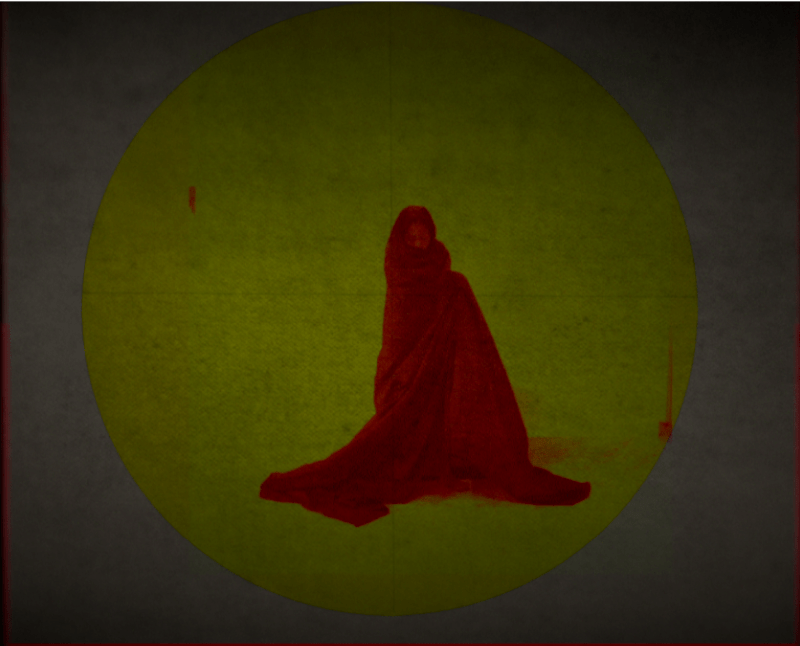
On the innermost wall in the dim basement of New Delhi’s Talwar Gallery, an image flickered to life. A red-robed woman, visage indiscernible, began moving slowly to a mournful thrum, the torpid choreography seemingly prolonging time. A lion, blackgarbed dancers, minuscule men with suitcases, and a body floating on water eventually appeared on the same screen in staccato, animated sequences. Abstruse yet mesmerizing, the video Life is fluid (2021) has the air of a séance, with phantom characters being “summoned” in the dark, inviting immersion rather than interpretation.
This occult quality permeated Kartik Sood’s solo exhibition “In Thin Air.” Featuring works from the past two years, the show drew on the romantic idiom. Romanticism emerged in the 18th-century to counter the then growing rationalization and regimentation of life and society by affirming the individual’s will, as well as one’s expansive emotional and spiritual experiences. As exemplified by Life is fluid’s surreal scenes, Sood’s works unsettle expectations of rational narrative, and foreground instead the atmospheric and emotional aspects of the self’s encounters with the world.
Elsewhere, “In Thin Air” aligned with the Romantic celebration of nature’s vastness. The paintings Traveling beneath, Face in the clouds, and Treasure (all 2019), for example, depict humans overpowered by alpine vistas, an homage to Sood’s Himalayan hometown of Shimla. The artist’s childhood memories haunt other works, firmly locating the show in his subjectivity. For instance, on the collaged canvas Domesticated sunset (2020), the protagonist hunched over the table, examining a miniature sunset, is a postman Sood remembers from his youth, while in Tilted sky (2020), the seemingly lunar terrain is in fact Shimla at night, graced with a fantastical “star-producing” contraption on the horizon. The mystical landscapes draw attention to the gap between humanity’s limited knowledge and the material realm’s mysteries. In our conversation, the artist confirmed an interest in transcending the world’s “superficial layer” and exploring the supersensible aspects of reality.
Sood’s Romantic preoccupation with superficies is literal as well. In his paintings, he plays with the perceived depth of the picture plane through the manipulation of scale, figures that appear recessed, and miniaturized and collaged insets. In most works, like Domesticated sunset, Territory problems (2020) and Daily theater to feed a family I-XII (2019), human figures are located in the middle ground, reduced in size and at a perspectival distance from the viewer, surrounded by forms both indecipherable and lucid, challenging a rational understanding of space. Elsewhere, cardboard cutouts (such as those in Roots and branches /fragmented family, 2019) and cast-iron protrusions (Touching the earth and passing the name, 2019) extend the flat surfaces while creating mutable shadows on the compositions.
In a time of bloodshed and unreason in India, when structures of state and society are imperiled by genocidal religiosity, a fascination with the numinous is fraught. When death is confronted earnestly, the result is pat—as in the unsubtly titled Color of blood is the same (2021), a two-part painting made after nationwide protests against an unconstitutional citizenship law featuring wounded citizens backlit and arranged against an archway. Perhaps a better approach to processing death under tyranny is irony. A foil to the paintings featuring sublime motifs and terrains, the watercolors Boy to have an elephant’s head and Trouble (both 2021) riff off the quotidian and take the form of absurdist tableaux. For instance, the Boy triptych conveys the transfiguration of the protagonist into part-beast, while Trouble is a diptych about a city beset by monkeys. The tinge of saffron in Boy recalls the palette embraced by the extremist Hindu right, while Trouble’s monkeys, notorious denizens of Delhi, are balanced on power cables, offering rich allegorical potential. Thus, a self-conscious humor undercuts the melancholia and nostalgia elsewhere in the show, a response to the conditions of contemporary India. Eschewing representation in favor of an oblique commentary on the trauma of fascism, these works link the ethereal to the material.
Animated by the legacy of Romanticism, Sood’s “In Thin Air” was expressive and eerie. In its questioning of the limits of the rational, it provoked reflections on the crisis of meaning prevailing in India and the world.
-Kamayani Sharma